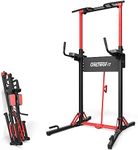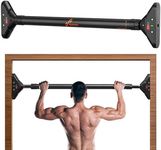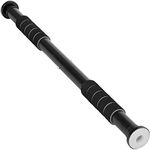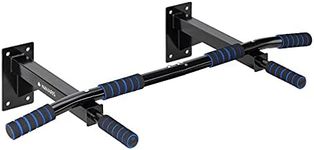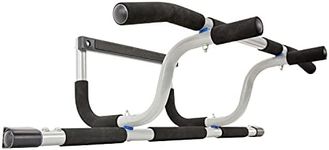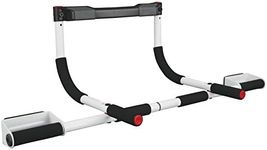Buying Guide for the Best Pull Up Bars
Choosing the right pull-up bar can significantly enhance your workout routine and help you achieve your fitness goals. When selecting a pull-up bar, it's important to consider various factors to ensure it meets your needs and fits your space. Here are some key specifications to look out for and how to navigate them.TypePull-up bars come in different types, including doorway, wall-mounted, ceiling-mounted, and free-standing. The type of pull-up bar you choose depends on your available space and how you plan to use it. Doorway pull-up bars are easy to install and remove, making them ideal for small spaces or temporary setups. Wall-mounted and ceiling-mounted bars are more permanent solutions that offer greater stability and can support more weight, suitable for dedicated workout areas. Free-standing pull-up bars provide versatility and can be moved around, but they require more space.
Weight CapacityWeight capacity refers to the maximum weight the pull-up bar can safely support. This is crucial for ensuring your safety during workouts. Pull-up bars typically have weight capacities ranging from 200 to 600 pounds. If you are heavier or plan to use additional weights during your exercises, opt for a bar with a higher weight capacity. Always check the manufacturer's specifications and choose a bar that can comfortably support your weight plus any additional load.
Grip OptionsGrip options refer to the different hand positions available on the pull-up bar. These can include wide grip, narrow grip, neutral grip, and angled grip. Having multiple grip options allows you to target different muscle groups and vary your workouts. If you want to perform a variety of exercises and work on different parts of your upper body, look for a pull-up bar with multiple grip positions. For basic pull-ups, a bar with standard grips will suffice.
Material and Build QualityThe material and build quality of a pull-up bar determine its durability and stability. Common materials include steel and high-quality metal alloys. A well-built pull-up bar will be sturdy, resistant to bending, and have a long lifespan. When choosing a pull-up bar, look for one made from strong, durable materials and check for any additional features like padded grips for comfort. A high-quality bar will provide a safer and more enjoyable workout experience.
Installation RequirementsInstallation requirements refer to the process and tools needed to set up the pull-up bar. Some bars, like doorway pull-up bars, require minimal installation and can be set up without any tools. Others, like wall-mounted or ceiling-mounted bars, may require drilling and additional hardware. Consider your comfort level with installation and whether you have the necessary tools and skills. If you prefer a hassle-free setup, opt for a bar with simple installation requirements.
AdjustabilityAdjustability refers to the ability to change the height or position of the pull-up bar. Adjustable pull-up bars can be beneficial if multiple people of different heights will be using the bar or if you want to perform a variety of exercises. Some bars offer adjustable height settings or can be repositioned easily. If you need flexibility in your workouts or share the equipment with others, look for a pull-up bar with adjustable features.
